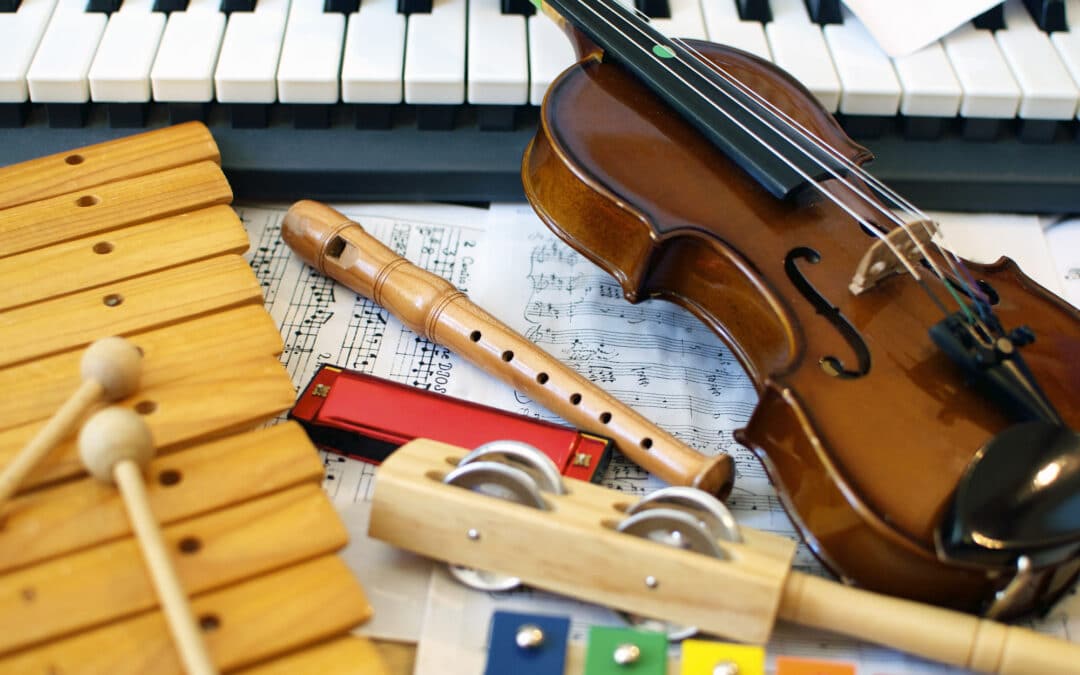Do you want your kids to learn Spanish as a second language, but they’d rather listen to music? Honestly, we get them! Music makes us want to cry, laugh, dance, and live. It gets to our deepest emotions, from the angriest feelings to the loveliest ones.
Through music we can understand those emotions. So, the best thing you can do for your kids is encourage them to keep listening to music. Even better, motivate them to play an instrument, whichever they like most.
Playing an instrument will bring tons of benefits and fun for your kids. And as a plus, it will help them with their Spanish language learning. That’s right, music and language studies can go hand in hand. Imagine picking up two amazing skills while having fun! To help your kids with that, we’ve gathered the names of some musical instruments in Spanish.
How playing an instrument helps with language learning
Develop the ear
Knowing how to play an instrument helps identify the differences between sounds. This is very important for second language learning, as each language has different sounds.
That’s why when learning a new language, you might find it difficult to understand and pronounce certain words. Because they have sounds that are different to the ones of your native language, the ones you’re used to.
But if you play an instrument, your ear is better developed to hear the details in every sound.
So, if your kids learn how to play an instrument from a young age, they’ll have a better development of their ear. That will help them hear even the slightest differences in sounds. Which will ultimately help them in their Spanish language learning journey.
Both music and language have rhythm
It’s true, language, just like music, has rhythm. Just remember how teachers usually teach you a new word or phrase, by separating it in syllabus and stressing one more than the others. Rhythm may be different in music and language, but it’s still a similarity they share.
So, let’s say you already know how to play an instrument. Then that could help you pick up the rhythm or understand how the rhythm of a new language works. Same for your kids, it’ll be easier for them to understand the rhythm of Spanish if they’ve already acquired rhythmic skills through music.
Types of musical instruments in Spanish
All musical instruments are classified in different types depending on how they produce their sound. Here’s the classification in both English and Spanish:
- Chordophones / String – Cordófonos / De cuerda
- Aerophones / Wind – Aerófonos / De viento
- Membranophones / Percussion – Membranófonos / De percusión
- Idiophones – Idiófonos
- Electrophones – Electrófonos
40 Musical instruments in Spanish
Here are the Spanish names of many different musical instruments from the most popular ones, to some that maybe you didn’t know:
- Piano – Piano
- Keyboard – Teclado
- Organ – Órgano
- Acoustic guitar – Guitarra acústica
- Electric guitar – Guitarra eléctrica
- Bass – Bajo
- Ukulele – Ukelele
- Drums – Batería
- Drum – Tambor
- Cymbals – Platillos
- Violin – Violín
- Cello – Violonchelo
- Harp – Arpa
- Accordion – Acordeón
- Clarinet – Clarinete
- Trumpet – Trompeta
- French horn – Trompa
- Saxophone – Saxofón
- Trombone – Trombón
- Tuba – Tuba
- Maracas – Maracas
- Triangle – Triángulo
- Flute – Flauta
- Oboe – Oboe
- English horn – Corno inglés
- Bassoon – Fagot
- Harmonica – Armónica
- Bagpipe – Gaita
- Xylophone – Xilófono
- Banjo – Banjo
- Bongos / Bongo drum – Bongó
- Bass drum – Bombo
- Kettledrum – Timbal
- Tambourine – Pandero
- Tambourine / Timbrel – Pandereta
- Rain stick – Palo de lluvia
- Panpipe – Siku / Zampoña
- Castanets – Castañuelas
- Mandolin – Mandolina
- Lyre – Lira
16 professions in Spanish for kids that dream about being musicians
Here’s how to say in Spanish the names of some musical professions, including a variety of musical instruments players. You’ll notice that a lot of the Spanish words for musical instrument players have a similarity: they end with “ista”.
- Singer – Cantante
- Orchestra conductor – Director de orquesta
- Musical composer – Compositor musical
- Musician – Músico
- Pianist – Pianista
- Guitarist / Guitar player – Guitarrista
- Drummer – Baterista
- Violinist – Violinista
- Cellist – Violonchelista / Chelista
- Trumpeter – Trompetista
- Flutist – Flautista
- Bassist – Bajista
- Saxophonist – Saxofonista
- Harpist – Arpista
- Clarinetist – Clarinetista
- Bongo player – Bongosero
Spanish phrases to talk about music
Here are some Spanish phrases and questions your kids can learn to talk about their music interests and musical instruments:
- Mi instrumento musical favorito es el piano. / My favorite musical instrument is the piano.
- Yo toco el saxofón. / I play the saxophone.
- Quiero aprender a tocar el bajo. / I want to learn how to play the bass.
- Voy a audicionar para el coro de la escuela. / I’m going to audition for the school choir.
- Voy a audicionar para la banda de la escuela. / I’m going to audition for the school band.
- Estoy en la banda de la escuela. / I’m on the school band.
- Voy a tocar el violín para el show de talentos de la escuela. / I’m going to play the violin for the school talent show.
- Cuando sea grande quiero ser baterista. / I want to be a drummer when I grow up.
- ¿Quién es tu músico favorito? / What’s your favorite musician?
- Mi pianista favorito es Chopin. / My favorite pianist is Chopin.
- ¿Qué tipo de música escuchas? / What type of music do you listen to?
- Mi género musical favorito es el rock. / My favorite musical genre is rock.
Learn Spanish Through Music with TruFluency Kids
Do you want your kids to have a fun and musical approach to the Spanish language? Then, you’re at the right place! Here at TruFluency Kids we teach Spanish for children through singing and dancing to songs in Spanish. We also have free blogs about songs in Spanish on our website to help parents with their kids Spanish music and language at home practice.
But that’s not it, we also teach through other fun activities, like word games, reading stories, crafting, and even cooking! Plus, there’s always time for kids to speak in every class, because that’s the best way they’ll achieve Spanish fluency.
Don’t worry about traffic or living in another state or even country., because our classes are completely online. We also offer flexible schedules: choose from all seven days of the week, from 9 am to 9 pm (CST).
Too good to be true? Check our testimonials! Or take a trial class. We are sure you’ll love it and will be more than ready to sign up your kids for our next 4-week session.





